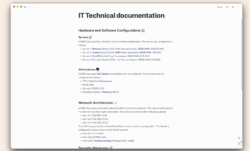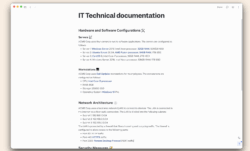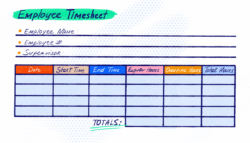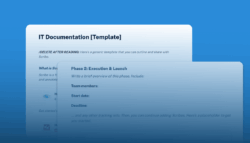Creating robust software is only half the battle. The other half, often overlooked but equally crucial, is documenting it properly. Think of it like this: you’ve built an incredible machine, but without a manual, how will anyone else understand how to use, maintain, or improve it? That’s where a good technical software documentation template comes in. It’s the user manual, the maintenance guide, and the architectural blueprint all rolled into one.
But diving into a blank document can be daunting. Where do you even begin? What sections are essential? What level of detail is needed? The good news is, you don’t have to reinvent the wheel. Numerous templates exist to guide you, providing a structured framework for capturing all the vital information about your software. These templates help ensure consistency, completeness, and ultimately, make your software more usable and maintainable.
This article will explore the importance of technical software documentation templates and how they can streamline your documentation process. We’ll discuss what makes a good template, key sections to include, and how to adapt it to your specific project needs. So, let’s unlock the power of effective software documentation and empower your users (and future developers) to thrive with your creation.
Why You Need a Solid Technical Software Documentation Template
Let’s be honest, documenting software isn’t usually anyone’s favorite task. It can feel tedious and time-consuming, especially when you’d rather be coding new features. However, neglecting documentation can have serious consequences. Imagine onboarding a new developer who has to spend weeks reverse-engineering existing code just to understand how it works. Or picture a user struggling to use your software because the instructions are unclear or outdated. These scenarios are avoidable with proper documentation.
A well-designed technical software documentation template provides a clear structure and helps you capture all the essential information about your software. It acts as a single source of truth for developers, users, and anyone else who interacts with your software. It reduces ambiguity, promotes consistency, and facilitates collaboration. Think of it as the DNA of your software project, carrying all the vital information for its survival and evolution.
Furthermore, good documentation enhances maintainability. When bugs arise or new features need to be added, having comprehensive documentation makes it easier to understand the existing codebase and make changes with confidence. This can significantly reduce development time and minimize the risk of introducing new errors. A template provides a standardized method for recording changes and updates, ensuring that the documentation remains current and accurate.
Another key benefit of using a template is that it promotes usability. Clear and concise documentation empowers users to learn how to use your software effectively. It can guide them through common tasks, troubleshoot problems, and explore advanced features. This leads to increased user satisfaction, reduced support requests, and ultimately, a more successful software product. A well-structured template encourages you to think from the user’s perspective and provide the information they need in a readily accessible format.
Ultimately, investing in a technical software documentation template is an investment in the long-term success of your software. It streamlines development, enhances maintainability, improves usability, and promotes collaboration. While it may require some upfront effort to create or customize a template, the benefits far outweigh the costs. It’s a crucial step in building robust, reliable, and user-friendly software.
Key Elements of a Great Documentation Template
Now that we’ve established the importance of technical software documentation templates, let’s dive into the key elements that make a template truly effective. The specific sections and level of detail will vary depending on the complexity and target audience of your software, but here are some common components to consider:
First and foremost, you should have a strong introduction or overview. This section should provide a high-level description of the software, its purpose, and its key features. Think of it as an executive summary that gives readers a quick understanding of what the software does and why it’s important. It should also outline the target audience for the documentation and any prerequisites needed to understand the material. Clear and concise writing is essential here, avoiding jargon and technical terms as much as possible.
Next, consider including a section on architecture and design. This is where you document the overall structure of the software, including its modules, components, and interactions. Diagrams and flowcharts can be incredibly helpful in visualizing the architecture and making it easier to understand. This section is particularly important for developers and maintainers who need to understand the inner workings of the software.
A dedicated section on API documentation is also crucial, especially for software that exposes an API for external integration. This section should provide detailed information about each API endpoint, including its parameters, request formats, and response formats. Examples and sample code can be incredibly helpful in demonstrating how to use the API effectively. Good API documentation is essential for attracting developers and fostering a vibrant ecosystem around your software.
Finally, don’t forget about user guides and tutorials. These sections should provide step-by-step instructions on how to use the software to accomplish specific tasks. They should be written in a clear and concise style, with plenty of screenshots and examples. User guides and tutorials are essential for empowering users to learn how to use your software effectively and get the most out of its features.
Remember, the best technical software documentation template is one that is tailored to your specific needs and audience. Don’t be afraid to customize and adapt the template to ensure that it provides the information your users and developers need in a clear, concise, and accessible format.
Ultimately, the time you invest in creating and maintaining effective software documentation will pay dividends in the long run. Your users will thank you, your developers will thank you, and your software will be more successful as a result. It’s a win-win situation for everyone involved.
By taking the time to carefully plan and execute your documentation strategy, you can ensure that your software is not only functional but also understandable and maintainable for years to come.



